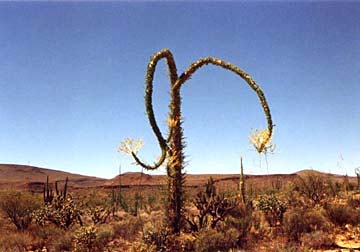The Speed of Rancho Santa Inés
Travel Stories: The saying goes: Bad roads, good people. Good roads, bad people. On a sleepy Mexican ranch, C.M. Mayo finds out what the Transpeninsular Highway brought to one stretch of Baja California.
10.18.06 | 4:05 PM ET
 Photo by C.M. Mayo.
Photo by C.M. Mayo.At Rancho Santa Inés there were no mules for our trip to Mission Santa María Cabukakaamung. The ranch hands had looked, but the mules had wandered through the desert too far in search of forage. Literally, they could not find them.
Nearing sundown, Alice and I sat at a picnic table under a thatched awning while the cook made scrambled eggs with machaca for our supper. A pot of beans bubbled on the stove. The smell of the cooking wafted out from the open kitchen. The wall by the counter was plastered with bumper stickers: I’D RATHER BE IN BAJA read one; KILL A BIKER… GO TO JAIL. Several were from the Baja 1000 off-road race, which used the ranch as a pit stop. Alice and I were the only guests tonight.
A small white poodle-like mutt nuzzled our legs. Palomito was his name, the cook said. A Calico cat slunk up as well, meowing loudly. And her name? “Gato,” she said. Cat. She broke out laughing at me, that I would ask.
A capable-looking woman with short hair graying at the roots, her name was Matilda Valdez. She sat with us at the picnic table while we ate. She’d lived here for 24 years, she said. No, she’d never been out to the mission. Her husband didn’t like her to leave the ranch house. “He says, you’re a housewife, so this is where you belong.”
As we spoke, the light faded. The ranch did not have electricity; Matilda switched on a small gas lamp.
When we were finished eating, she sighed and rested her chin in her hands. “I would like to go to the United States,” she said. “I like the style of life there. But I’m too old now, I wouldn’t know how to live there. What would I do?”
In the morning, for breakfast we ate eggs and machaca again; it was all they had. Matilda shooed away the cat, then went back into the kitchen where she lingered like a shadow, washing dishes. At 8 a.m., it was already broiling hot. And strangely quiet—there were no chickens here, no goats. I watched Palomito sniff around our jeep, lifting his leg on each tire, and I thought of all the dogs that had marked them over the past several days.
“Doggie bush mail,” I said.
Alice sipped her coffee. “More like message in a bottle.”
Matilda’s husband was named Oscar Valdez. Trim and tough-looking, he had a pencil-thin mustache and eyes that peered out hard and slit-like from beneath a crisply molded white cowboy hat. On his belt he wore a turquoise-encrusted silver buckle.
I still had my hopes of getting to Mission Santa María Cabujakaamung. Was the road really impassable?
“Es malo,” it’s bad, Oscar said, “muy malo.” It used to be better; he’d built it himself, together with his father and cousins in the sixties. But it hadn’t been kept up, chubascos had washed out large sections. We could hike to the mission and camp overnight, he suggested.
We’d lost that time, I explained. Alice had to catch her flight from Loreto, to be back at work.
He swung a leg over the bench of the picnic table. Palomito leapt up and laid his chin on Oscar’s lap. The mission was just ruins, he said, not much to see. But he had a picture in a book from the 1920s that showed the adobe walls still standing. Gently, he patted the little dog behind its ears.